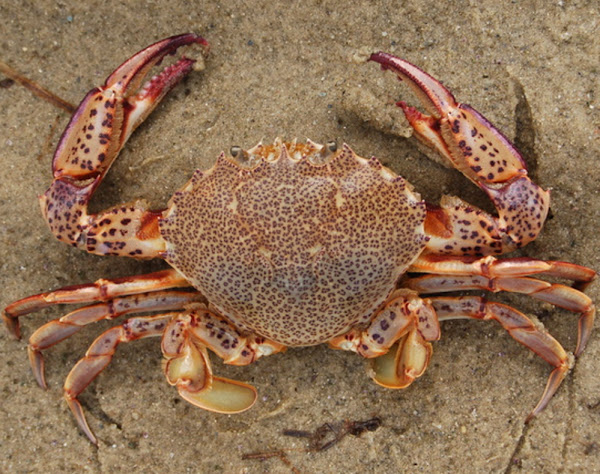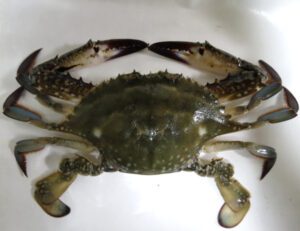The Lady crab is a species of crab from eastern North America. It is also known by some other names such as Leopard Crab, Atlantic Leopard Crab, Ocellated crab, Calico crab, Ocellate Lady crab, Sand crab, Calico crab etc.
The crab is named so (Lady) mainly because of the beautiful color patterns on the shell.
It generally occurs from Canada to Georgia, and it lives mainly on molluscs such as the Atlantic Surf Clam.
It is probably the only Ovalipes species common north of Virginia, being replaced by Ovalipes stephensoni to the south. Read some more information about this crab species below.
Lady Crab Characteristics
The Lady crab has yellow-grey or light purplish carapace, with ‘leopardlike clusters of purple dots’, and 3-5 spines along the edge behind each eye.
Their coloring appears iridescent in the water and under direct sunlight. They have sharp, powerful pinchers which are whitish in color with purple-spotted tips and jagged teeth.
The last pair of legs are modified into paddles and are adapted for swimming. Their tail is tucked underneath the body and lies against the abdomen.
Tail of the male Lady crabs is pointed and narrow, while the tail of the female crabs is shaped like a rounded triangle.
The carapace of the Lady crab is slightly wider than long. The carapace is around 8.9 cm wide and around 7.5 cm long. Photo and info from Wikipedia.

Diet
The Lady crabs are mostly feed on molluscs, particularly the Atlantic Surf Clam. They are scavengers like most other crabs.
And their diet include both dead and live fish, crabs and other invertebrates. They can also rapidly consume small clams and prey upon hard clams.
Breeding
The Lady crab breeds year round. The females use their tails to cover their eggs.
The young crabs hatch in the early summer months, beginning their lives as zooplankton, and they settle to the bottom by early fall.
Uses
The Lady crabs are used for food, but they are less popular. Their meat is not considered as tasty as that of other crabs. So they are not harvested commercially.
Special Notes
The Lady crabs are generally found throughout the Bay, on sandy or muddy bottoms and often in shallow waters. They are known for their aggressive disposition and sharp claws.
They are often seen partially buried in sand with only their eyestalks protruding. They will dart out of their hiding place using their powerful paddles to swim after their prey.
They are migratory within Rhode Island waters, and at certain times of the year they make up a large proportion of Rhode Island’s overall crab population.
The Oyster toadfish, tautog, striped bass, American lobsters, and other crabs prey upon Lady crabs. It is used for food in some areas. But the meat is not considered as tasty as that of other crabs.
So the Lady crabs are not harvested commercially. However, review full breed profile of the Lady crab in the following table.
| Name | Lady Crab |
| Kingdom | Animalia |
| Phylum | Arthropoda |
| Class | Malacostraca |
| Order | Decapoda |
| Family | Portunidae |
| Genus | Ovalipes |
| Species | O. ocellatus |
| Binomial Name | Ovalipes ocellatus |
| Other Names | Also known as Leopard Crab, Atlantic Leopard Crab, Ocellated crab, Calico crab, Ocellate Lady crab, Sand crab, Calico crab etc. |
| Breed Purpose | Food |
| Special Notes | Prefer to live on sandy or muddy bottoms and often in shallow waters, known for their aggressive disposition and sharp claws, used for food in some areas, but not popular for food because it is not as tasty as other crabs, not harvested commercially |
| Breeding Method | Natural |
| Climate Tolerance | Native climate |
| Body Color | White to yellowish grey, with reddish purple mottled spot over body and claws |
| Rarity | Common |
| Availability | North America |






